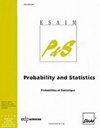具有一般暴露期和传染期的多斑块流行病模型
IF 0.7
4区 数学
Q4 STATISTICS & PROBABILITY
引用次数: 7
摘要
我们研究了多斑块流行病模型,其中个体可能以易感、暴露/潜伏、感染和恢复状态中的任何一种从一个斑块迁移到另一个斑块。我们假设感染既发生在局部,其发生率取决于贴片,也取决于与所有其他贴片的“距离”。暴露期和感染期具有普遍分布,不受个体可能迁移的影响。在这三种状态中的任何一种迁移过程都假定是马尔可夫的,并且独立于暴露期和感染期。建立了易感过程、暴露/潜伏过程、感染过程和恢复过程的泛函大数律和函数中心极限定理。在FLLN中,极限由一组Volterra积分方程确定。在确定性暴露期和传染期的特殊情况下,极限变成了一个有延迟的ode系统。在FCLT中,极限由一组由独立布朗运动和具有显式协方差结构的连续高斯过程和驱动的随机Volterra积分方程给出。本文章由计算机程序翻译,如有差异,请以英文原文为准。
Multi-patch epidemic models with general exposed and infectious periods
We study multi-patch epidemic models where individuals may migrate from one patch to another in either of the susceptible, exposed/latent, infectious and recovered states. We assume that infections occur both locally with a rate that depends on the patch as well as ``from distance" from all the other patches. The exposed and infectious periods have general distributions, and are not affected by the possible migrations of the individuals. The migration processes in either of the three states are assumed to be Markovian, and independent of the exposed and infectious periods. We establish a functional law of large number (FLLN) and a function central limit theorem (FCLT) for the susceptible, exposed/latent, infectious and recovered processes. In the FLLN, the limit is determined by a set of Volterra integral equations. In the special case of deterministic exposed and infectious periods, the limit becomes a system of ODEs with delays. In the FCLT, the limit is given by a set of stochastic Volterra integral equations driven by a sum of independent Brownian motions and continuous Gaussian processes with an explicit covariance structure.
求助全文
通过发布文献求助,成功后即可免费获取论文全文。
去求助
来源期刊

Esaim-Probability and Statistics
STATISTICS & PROBABILITY-
CiteScore
1.00
自引率
0.00%
发文量
14
审稿时长
>12 weeks
期刊介绍:
The journal publishes original research and survey papers in the area of Probability and Statistics. It covers theoretical and practical aspects, in any field of these domains.
Of particular interest are methodological developments with application in other scientific areas, for example Biology and Genetics, Information Theory, Finance, Bioinformatics, Random structures and Random graphs, Econometrics, Physics.
Long papers are very welcome.
Indeed, we intend to develop the journal in the direction of applications and to open it to various fields where random mathematical modelling is important. In particular we will call (survey) papers in these areas, in order to make the random community aware of important problems of both theoretical and practical interest. We all know that many recent fascinating developments in Probability and Statistics are coming from "the outside" and we think that ESAIM: P&S should be a good entry point for such exchanges. Of course this does not mean that the journal will be only devoted to practical aspects.
 求助内容:
求助内容: 应助结果提醒方式:
应助结果提醒方式:


